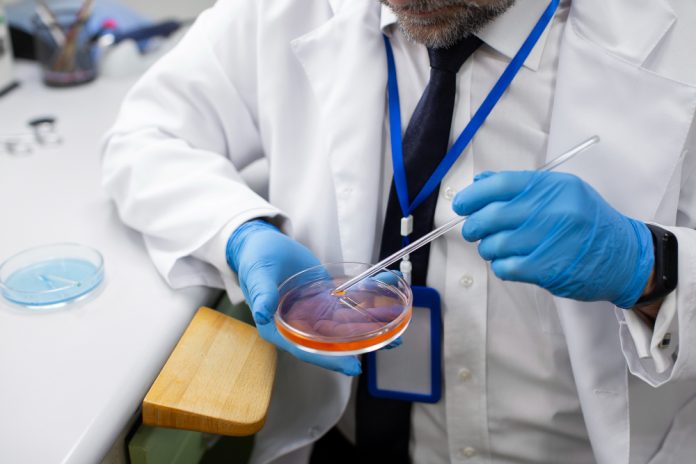Food is a common factor which binds people from all over the world. People extend different cultures and culinary traditions based on their own history and climatic conditions. Today we live in a world where people are inspired all the time to create new recipes and innovative food. But the focus of our generation is to be healthy with balanced home-cooked meals whereas ordering take-out and eating packaged food has become the norm. Let’s see how Lab-grown meat is produced.
Industry has revolutionized the way people eat and consume meat. The first cultured beef burger patty was created in 2013 at Maastricht University, Netherlands. Made from over 20,000 thin strands of muscle tissue, it took 2 years to be produced with a cost of about $300,000. This burger was tested on live television in London as well.
Lab-grown meat, which is said to be cultivated meat, is real meat that’s grown directly from animal cells. Scientists can have a sample of cells from a living organism and get a sample to grow outside of the animal’s body, shaping it into a fully formed sample of meat. It would all have the same taste consumers expect it to be and no animal would be needed to be slaughtered to create the food.
Environmental Benefits:
Lab-grown meat has various potential benefits to reduce the environmental impacts of the traditional ways of farming livestock. Producing meat can be associated with a lot of environmental issues such as deforestation, high water usage and harmful gas emissions. With the usage of Lab-grown meat, environmental issues can decline significantly offering sustainable options to the consumers.
Ethical Considerations:
For people choosing plant-based meat for ethical reasons, Lab-grown meat provides a good option, as removing the need for animal slaughter, gives a green signal to animal welfare and also reduces harm altogether on the production of the food. It also makes us as humans contribute to nature and the environment as a whole.
Pros and cons of lab-grown meat
The welfare of the animals is one of the most important reasons for cultivating lab-grown meat. This prevents a lot of the animals from being Slaughtered and has a lot of potential in the future prospects. But the process majorly relies on the stem cells obtained from a living animal and the most widely used medium contains fetal bovine serum (FBS) which is again from Foetal blood so it cannot be regarded as completely slaughter-free
Some of the experts on the lab-grown mean also regard it to be a safety leverage it is made in a controlled environment of the lab and hence it won’t face any traditional risk of contamination of illness and bacteria causing germs. However, it is not completely risk-free as it can still contain microbiological or chemical contaminations.
Sustainable production of protein will be crucial in the upcoming years and with that consideration world population is surely going to increase hence it is important to move ahead with a more environmentally friendly approach as it will use less of some resources such as water, land, fertilizers as compared to the traditional way of growing crops and livestock.
Suitability for vegetarians or vegans
Earlier in the day, vegans and vegetarians would have declined the idea of lab-grown meat entirely, as it uses foetal bovine serum (FBS) for the medium of the growth. However various companies have been working to replace FBS with a growth medium which doesn’t use animals as the medium, adding to the news it was achieved for the first time in 2022. As Lab-grown meat is still considered to be meat, those who refuse to eat meat for the welfare of the animal choose it when it is cultivated in this manner
In the early days, vegans and vegetarians would have rejected lab-grown meat completely, because it used foetal bovine serum (FBS) as the growth medium. However since then, companies have been working to replace FBS with a growth medium that doesn’t come from animals, and this was achieved for the first time in 2022.8 While lab-grown meat is still considered meat, those who refuse to eat meat for animal welfare reasons may choose to eat it when produced in this way.
Will lab-grown meat replace the traditional meat?
Consumers’ acceptability will play a key role in whether or not lab-grown meat replaces traditional meat, it can be said that it will replace it to a significant percentage of the consumers.
Reports indicate that people still are quite reluctant to accept the new lab-grown meat concept but it can be influenced if the transparency is maintained and proper information is said out loud. As there is not much study information we do not know how it tastes and what will its texture be like compared to real meat.
Also, the nutritional value is questioned with regards to the traditional meat. It is because the lab-grown meat is expensive and most of its knowledge is known by the company who invested in the technology. There are not many samples available for independent researchers, so much of the available data is so far either theoretical or based on information provided by start-ups themselves
Here are some of the leading lab-grown meat companies in 2023:
- Vow
- JBS, USA
- Omeat
- Everafter foods
- UPSIDE foods
Lab-grown meat is certainly a concept made for the future. With advancements in technology and a commitment to addressing ethical and environmental concerns, it has the potential to reshape the landscape of our food industry. As we navigate the complex relationship between food production and sustainability, lab-grown meat stands as a beacon of hope for a more ethical and environmentally conscious future.





























